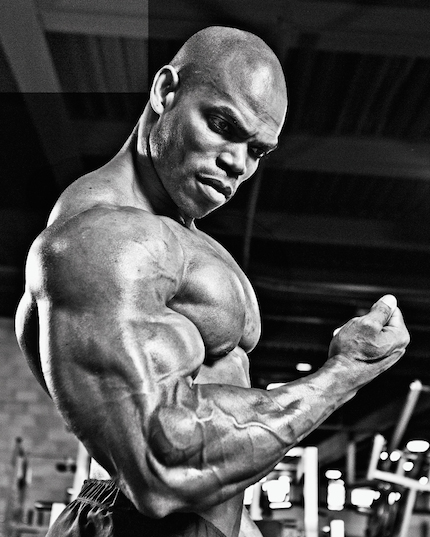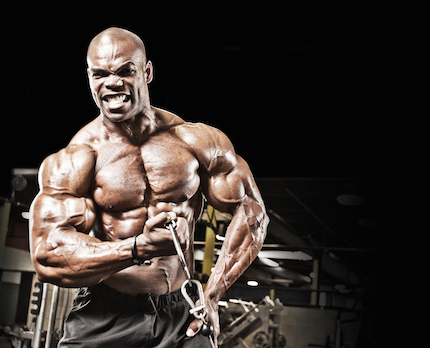Bicep Blitz with IFBB Pro Chris White

Chris White Biceps Blitz
By John Romano
Our world is split into two camps: legit old-school hardcore bodybuilders and everyone else. Spend five minutes with IFBB pro Chris White and you know he is an old-school iron baller. And he knows it too. There’s a noticeable ease about a guy who’s sure he’s pulling it all together the right way; two weeks before the Toronto Pro, Chris sounded to me like he was in Maui under a palm tree. Not like a guy struggling into his last two weeks of dial-in for a prestigious IFBB pro show—going into the 212 class for the first time, no less! Nope, in the image I got in my mind talking to Chris, he had a piña colada in his hand.
When asked why that’s so—what motivates such chillness just days before battle—Chris enthusiastically said, “Life is good! I’m on this side of the grass, doing what I love to do and teaching people something good that makes me feel good when I see them improve.”
That’s nice to hear. Bodybuilding is typically a very selfish endeavor. Pull from it what we can and ply it on those whose lives we improve is about the best form of balance this industry has to offer. It’s always good to see someone paying it forward with such resolve. Such an attitude can only motivate a very positive training experience—certainly in this case.
During the course of our interview, Chris gave credit to several ’80s and ’90s bodybuilding marvels from whom he borrows elements to create his training method, both on- and off-season. It was all too easy to veer away from the point of the interview and reminisce about a time in our age when monsters first started to hatch. I had to keep reeling us back in. The point of this article is his biceps training. But, before we get into reps and sets, lets talk about his training philosophy.

“I train HIT off-season…”
I cut him off right there. “Whoa … hold on, bro. Before we stray too far from what you just said, lets make it clear right now what you mean by HIT. A lot of guys tell me how they train HIT, and then they start spitting it out and I’m like, ‘no way.’ They have no clue what Arthur Jones meant.”
Chris laughed right along with me. “I know … I know …” He fought back his laughter. “I see it all the time too. No … no … You can ask my training partner. I know right where the failure button is.”
“So, how do you find it?” I asked. “Give us an idea of your HIT style.”
“I pyramid up for 4 sets, up in weight as high as I can and then back down 4 sets, pushing them out until I can’t do another rep without help. The last one is a drop set—to failure—until I can’t go anymore. Nothing. My brain says ‘move,’ but my body says ‘uh-uh.’ My training partner has to pull the bar off me. Dead.”
That is the correct answer. Once you get to that point where the body is disagreeing with the brain, then you’ve reached Valhalla. So, yes, I approve. So too would Arthur Jones. Chris White is a certified HIT master.
The power moves depicted here are the ones Chris uses in the off-season for high-intensity workouts. And we know he does them right. For contest prep, however, the moves stay the same, but training style shifts to accumulate more volume with lighter weights. “Six sets of 15 reps,” he says, “nice and slow.” Barbell curls go up to 90 to 95 pounds on the bar. “I take it nice and slow all the way up and down. Shoulder-width grip, curl it from the bottom to the top. No swinging. I rack it for about two minutes and then hit it again. Six sets, nice and slow…”
I know guys who believe in this exercise like religion while others ignore it. “You’re obviously from the believers’ camp,” I said. “What originally sold you?”
“Oh man, standing barbell curls is one of the best old-school exercises there is to put size on your arm. Bertil Fox, you remember him?”
How could anyone not remember Bertil Fox? “Of course I remember him!”
“He had the biggest set of arms there was,” Chris said. “And the strongest. He was the first person I ever saw who put 45-pound plates on a bar and did curls. When I saw that? Brother, that’s what I wanted!”
Standing alternating dumbbell curls are next. This exercise, as well as all the rest in this routine, is performed for six sets of 15 reps—nice and slow—on each side. “This is an exercise that I can actually feel and see work,” Chris said. “I like to be in front of the mirror so I can see it.”

This is an exercise I always see guys doing, flopping around and doing the most ludicrous things to their spines, but everything Chris does, he assured me, is controlled.
Especially this particular exercise. “It’s one of those exercises I’ve just kind of always done,” he said. “But after a while, I realized I needed to slow it down and I could get more out of it. When I watch myself in the mirror, I can see the muscle working. It makes me feel a whole lot better about it.”
Next come cross-body dumbbell hammer curls. “Crazy forearms come from doing hammers. Look at that muscle at the elbow joint ... doesn’t that look right? It just looks right.”
I imagined him holding up a flexed forearm and the phone in the other hand. There was no doubt in my mind that he was doing that.
“I used to see guys like Mike Christian doing them—he was a strong beast! I’d look at those forearms and just want them! You can’t buy them. I’d see him doing them and figured that was it.”
“So, you’d consider hammers a strong foundational move?”
“It’s a staple backbone exercise for me,” Chris replied. “When you put a side chest pose together… if you don’t have no forearms—shit, that’s a great reason to get those hammer curls in there. You can’t put together a side chest pose without some crazy forearms.”
Seated machine preacher curls take us back once again to the old school. “Remember Albert Beckles? He had peaks, upon peaks, upon peaks! And I want those! The only way to get them is to get on the preacher machine and do them!”
Chris actually got a chance to talk to Beckles and asked him how he built those peaks. “He said, ‘You have to take your time and keep at them … and do them and do them and keep doing preacher curls.’”
That pretty much squashes any argument to the contrary. If Albert Beckles tells you to do preacher curls, by and large, you do them.
Chris finishes off with standing low cable curls (with D-handle). “This is a shaping exercise to me to get that peak to come up even more,” he said. “When you turn around from behind and hit a back double biceps, you want to see those peaks popping up!”
“Is the inclusion of this exercise rooted in the training of some iconic bodybuilder?” I asked.
“I never really saw anyone doing them,” he replied. “I was just messing around one day and decided to try them. I really liked the way they felt, so I kept them in there.”
When we talked about training splits, Chris admitted that he trains biceps twice a week. Twice a week plus indirectly with back? I think some would consider that overtraining. To this, Chris replied, “My training is for me. You can try my training, but it’s not for you. Some people might do my training and be overtrained. Not me. This is what works for me. This is what is going to enhance my physique. I like doing it, and I’m going to keep on doing it.”

SIDE BAR
Feeding the Beast: Chris White on Nutrition
Off-season, I stick to foods I can put weight on with. I call those “heavy proteins”: chicken, turkey, and beef.
On-season, I switch to fish and veggies. I even cut out egg whites (two weeks prior to contest). Now I’m just eating tilapia with broccoli, asparagus, or zucchini.
For carbs, on-season or off, I stick to nice low glycemic yams. I keep fats keep really low. I find that my body doesn’t really need much fat. I do better on carbs. Some guys do better on fats. It’s whatever you find that works for you. I find this is what works for me:
Protein: 65%
Carbohydrate: 30%
Fat: 5%
And for my cheat? My thing is white chocolate chip macadamia nut cookies—and peanut butter. You put some of that in between the cookies and oh man, that’s a date!
To read more 'NO BS' articles and interviews from John Romano, click here!

